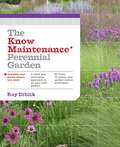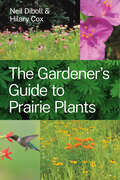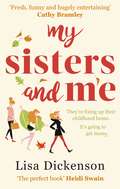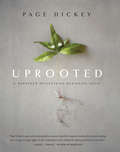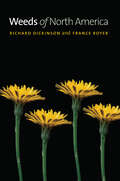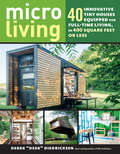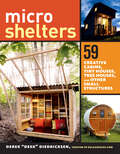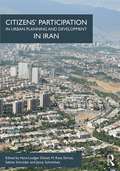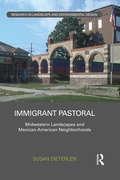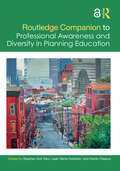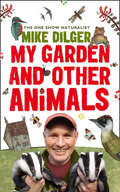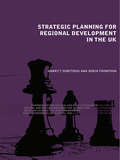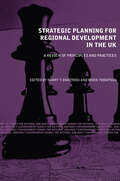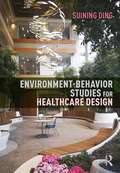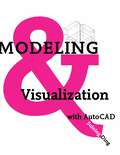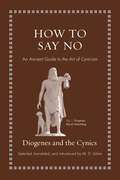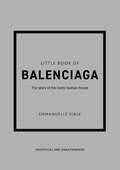- Table View
- List View
The Know Maintenance Perennial Garden
by Roy DiblikThe Know Maintenance Perennial Garden makes a gorgeous perennial garden available to everyone, no matter their skill or the size of their space.
The Gardener's Guide to Prairie Plants
by Neil Diboll Hilary CoxA comprehensive and beautifully illustrated reference for all gardeners passionate about native plants and prairie restoration. The Gardener’s Guide to Prairie Plants is the one-stop compendium for all gardeners aspiring to use native prairie plants in their gardens. Neil Diboll and Hilary Cox—two renowned prairie gardeners—compile more than four decades’ worth of research to offer a wide-ranging and definitive reference for starting and maintaining prairie and meadow gardens and restorations. Alongside detailed synopses of plant life cycles, meticulous range maps, and sweeping overviews of natural history, Diboll and Cox also include photographs of 148 prairie plants in every stage of development, from seedling to seedhead. North America’s grasslands once stretched from the Blue Ridge to the Rocky Mountains, and from Texas to Manitoba, blanketing the mid-continent with ecologically important, garden-worthy, native species. This book provides all the inspiration and information necessary for eager native planters from across the country to welcome these plants back to their landscapes. The Gardener’s Guide to Prairie Plants is a must-have reference for gardeners, restorationists, and every flora fan with a passion for native plants, prairies and meadows.
The Gardener's Guide to Prairie Plants (Emersion: Emergent Village Resources For Communities Of Faith Ser.)
by Neil Diboll Hilary CoxA comprehensive and beautifully illustrated reference for all gardeners passionate about native plants and prairie restoration. The Gardener’s Guide to Prairie Plants is the one-stop compendium for all gardeners aspiring to use native prairie plants in their gardens. Neil Diboll and Hilary Cox—two renowned prairie gardeners—compile more than four decades’ worth of research to offer a wide-ranging and definitive reference for starting and maintaining prairie and meadow gardens and restorations. Alongside detailed synopses of plant life cycles, meticulous range maps, and sweeping overviews of natural history, Diboll and Cox also include photographs of 148 prairie plants in every stage of development, from seedling to seedhead. North America’s grasslands once stretched from the Blue Ridge to the Rocky Mountains, and from Texas to Manitoba, blanketing the mid-continent with ecologically important, garden-worthy, native species. This book provides all the inspiration and information necessary for eager native planters from across the country to welcome these plants back to their landscapes. The Gardener’s Guide to Prairie Plants is a must-have reference for gardeners, restorationists, and every flora fan with a passion for native plants, prairies and meadows.
My Sisters And Me: THE Hilarious, Feel-Good Book To Curl Up With
by Lisa DickensonMeet the Lake sisters... 'Fresh, funny and hugely entertaining' CATHY BRAMLEY'The perfect book!' HEIDI SWAIN'Cracking, cosy, emotional and witty'KIRSTY GREENWOOD 'You are all going to completely fall in love with this story' HOLLY MARTIN 'A feel-good hoot of a read' HEAT The BRAND NEW feel-good, kick-ass novel about sisterhood and second chances. Perfect for fans of Sophie Kinsella, Lindsey Kelk, Mhairi McFarlane and Anna Bell. **** They're fixing up their childhood home. It's going to get messy. When Willow Lake asks her daughters for help renovating the family home, each has a reason to hesitate about returning to Maplewood . . . For quiet and bookish Emmy going back to the town that ridiculed her fills her with dread. The youngest Noelle is perfectly comfortable in herself now, but once wanted to fit in so badly that she walked away from her first love. A first love who still lives in Maplewood. And outspoken Rae is painfully aware of how much the townspeople hurt her little sisters growing up. She didn't protect them then, but there's no way she'll let history repeat itself. The sisters agree to go home and make the best of it. After all if they've changed over the years, it's possible the townspeople have too . . . isn't it? The BRAND NEW feel-good, kick-ass novel about sisterhood and second chances. Perfect for fans of Sophie Kinsella, Lindsey Kelk, Mhairi McFarlane and Anna Bell. Praise for Lisa Dickenson 'PERFECT' - Miranda Dickenson 'FLAWLESS' - Holly Martin 'Sprinkled with humour' - Cathy Bramley 'HILARIOUS' - Fabulous 'Will have you laughing out loud... A must read' - Daily Express 'DELICIOUS' - Jo Thomas 'A classic' - Sun 'SPARKLING' - Sunday Express 'Feisty, fun, and fierce!' - Ali McNamara 'HEART-WARMING' - Red 'Perfect poolside reading' - The Lady 'LOVELY' - Marie Claire 'UPLIFTING' - Bella
Uprooted: A Gardener Reflects on Beginning Again
by Page DickeyThe engaging story of leaving a beloved garden and creating a new, very different garden, by one of America&’s best-known and most accomplished garden writers.
The Gardening Year (Collins Big Cat Ser.)
by Becky Dickinson Collins StaffSpring, Summer. Autumn. Winter. The garden changes with every season of the year. New surprises, new shoots and new jobs for the gardener. •Orange/ Band 6 books offer varied text and characters, with action sustained over several pages.
Weeds of North America
by Richard Dickinson France Royer“What is a weed,” opined Emerson, “but a plant whose virtues have not yet been discovered?” While that may be a worthy notion in theory, these plants of undiscovered virtue cause endless hours of toil for backyard gardeners. Wherever they take root, weeds compete for resources, and most often win. They also wreak havoc on industry—from agriculture to golf courses to civic landscape projects, vast amounts of money are spent to eradicate these virile and versatile invaders. With so much at stake, reliable information on weeds and their characteristics is crucial. Richard Dickinson and France Royer shed light on this complex world with Weeds of North America, the essential reference for all who wish to understand the science of the all-powerful weed. Encyclopedic in scope, the book is the first to cover North American weeds at every stage of growth. The book is organized by plant family, and more than five hundred species are featured. Each receives a two-page spread with images and text identification keys. Species are arranged within family alphabetically by scientific name, and entries include vital information on seed viability and germination requirements. Whether you believe, like Donald Culross Peattie, that “a weed is a plant out of place,” or align with Elizabeth Wheeler Wilcox’s “weeds are but unloved flowers,” Dickinson and Royer provide much-needed background on these intrusive organisms. In the battle with weeds, knowledge truly is power. Weeds of North America is the perfect tool for gardeners, as well as anyone working in the business of weed ecology and control.
Weeds of North America
by Richard Dickinson France Royer“What is a weed,” opined Emerson, “but a plant whose virtues have not yet been discovered?” While that may be a worthy notion in theory, these plants of undiscovered virtue cause endless hours of toil for backyard gardeners. Wherever they take root, weeds compete for resources, and most often win. They also wreak havoc on industry—from agriculture to golf courses to civic landscape projects, vast amounts of money are spent to eradicate these virile and versatile invaders. With so much at stake, reliable information on weeds and their characteristics is crucial. Richard Dickinson and France Royer shed light on this complex world with Weeds of North America, the essential reference for all who wish to understand the science of the all-powerful weed. Encyclopedic in scope, the book is the first to cover North American weeds at every stage of growth. The book is organized by plant family, and more than five hundred species are featured. Each receives a two-page spread with images and text identification keys. Species are arranged within family alphabetically by scientific name, and entries include vital information on seed viability and germination requirements. Whether you believe, like Donald Culross Peattie, that “a weed is a plant out of place,” or align with Elizabeth Wheeler Wilcox’s “weeds are but unloved flowers,” Dickinson and Royer provide much-needed background on these intrusive organisms. In the battle with weeds, knowledge truly is power. Weeds of North America is the perfect tool for gardeners, as well as anyone working in the business of weed ecology and control.
Weeds of North America
by Richard Dickinson France Royer“What is a weed,” opined Emerson, “but a plant whose virtues have not yet been discovered?” While that may be a worthy notion in theory, these plants of undiscovered virtue cause endless hours of toil for backyard gardeners. Wherever they take root, weeds compete for resources, and most often win. They also wreak havoc on industry—from agriculture to golf courses to civic landscape projects, vast amounts of money are spent to eradicate these virile and versatile invaders. With so much at stake, reliable information on weeds and their characteristics is crucial. Richard Dickinson and France Royer shed light on this complex world with Weeds of North America, the essential reference for all who wish to understand the science of the all-powerful weed. Encyclopedic in scope, the book is the first to cover North American weeds at every stage of growth. The book is organized by plant family, and more than five hundred species are featured. Each receives a two-page spread with images and text identification keys. Species are arranged within family alphabetically by scientific name, and entries include vital information on seed viability and germination requirements. Whether you believe, like Donald Culross Peattie, that “a weed is a plant out of place,” or align with Elizabeth Wheeler Wilcox’s “weeds are but unloved flowers,” Dickinson and Royer provide much-needed background on these intrusive organisms. In the battle with weeds, knowledge truly is power. Weeds of North America is the perfect tool for gardeners, as well as anyone working in the business of weed ecology and control.
Weeds of North America
by Richard Dickinson France Royer“What is a weed,” opined Emerson, “but a plant whose virtues have not yet been discovered?” While that may be a worthy notion in theory, these plants of undiscovered virtue cause endless hours of toil for backyard gardeners. Wherever they take root, weeds compete for resources, and most often win. They also wreak havoc on industry—from agriculture to golf courses to civic landscape projects, vast amounts of money are spent to eradicate these virile and versatile invaders. With so much at stake, reliable information on weeds and their characteristics is crucial. Richard Dickinson and France Royer shed light on this complex world with Weeds of North America, the essential reference for all who wish to understand the science of the all-powerful weed. Encyclopedic in scope, the book is the first to cover North American weeds at every stage of growth. The book is organized by plant family, and more than five hundred species are featured. Each receives a two-page spread with images and text identification keys. Species are arranged within family alphabetically by scientific name, and entries include vital information on seed viability and germination requirements. Whether you believe, like Donald Culross Peattie, that “a weed is a plant out of place,” or align with Elizabeth Wheeler Wilcox’s “weeds are but unloved flowers,” Dickinson and Royer provide much-needed background on these intrusive organisms. In the battle with weeds, knowledge truly is power. Weeds of North America is the perfect tool for gardeners, as well as anyone working in the business of weed ecology and control.
Micro Living: 40 Innovative Tiny Houses Equipped for Full-Time Living, in 400 Square Feet or Less
by Derek “Deek” DiedricksenLive tiny without sacrificing the comforts of home with Derek &“Deek&” Diedricksen&’s lively exploration of 40 small dwellings outfitted with features essential to full-time, year-round living — complete with floor plans, real experiences, and expert tips from tiny house residents.
Microshelters: 59 Creative Cabins, Tiny Houses, Tree Houses, and Other Small Structures
by Derek “Deek” DiedricksenDiscover how "big" tiny can be! With stunning photographs, fascinating information, and plans to build your own, Microshelters proves that small structures are not only useful, but stylish as well.
Citizens' Participation in Urban Planning and Development in Iran
by Hans-Liudger Dienel M. Reza Shirazi Sabine Schröder Jenny SchmithalsDuring recent years, the topic of participation has increasingly been gaining importance in Iran – in the scientific field, in practice and rhetoric. However, in current scientific literature – and especially in English literature – there is little knowledge on the conditions, legal background, perceptions, experiences and processes of citizens’ participation in Iran. This book aims to shed light on the paradoxical question of participation in Iran: it is old and new, dysfunctioning and functioning, disappointing and promising. This slippery status of participation convinces scholars to suggest contradictory interpretations and understandings about the existence, functionality, and potentiality of this concept. The book therefore shows the different perspectives, interpretations, historical developments and case studies of participation in Iran, thus giving the reader a kaleidoscope view on the question of participation in Iran.
Immigrant Pastoral: Midwestern Landscapes and Mexican-American Neighborhoods (Routledge Research in Landscape and Environmental Design)
by Susan DieterlenImmigrant Pastoral examines the growth of new Mexican heritage communities in the Midwest through the physical form of their cities and neighborhoods. The landscapes of these New Communities contrast with nearby small cities that are home to longstanding Mexican-American communities, where different landscapes reveal a history of inequality of opportunity. Together these two landscape types illustrate how inequality can persist or abate through comprehensive descriptions of the three main types of Midwestern Mexican-American landscapes: Established Communities, New Communities, and Mixed Communities. Each is described in spatial and non-spatial terms, with a focus on one example city. Specific directives about design and planning work in each landscape type follow these descriptions, presented in case studies of hypothetical landscape architectural projects. Subsequent chapters discuss less common Midwestern Mexican-American landscape types and their opportunities for design and planning, and implications for other immigrant communities in other places. This story of places shaped by immigrants new and old and the reactions of other residents to their arrival is critical to the future of all cities, towns, and neighborhoods striving to weather the economic transformations and demographic shifts of the twentieth and twenty-first centuries. The challenges facing these cities demand the recognition and appreciation of their multicultural assets, in order to craft a bright and inclusive future.
Immigrant Pastoral: Midwestern Landscapes and Mexican-American Neighborhoods (Routledge Research in Landscape and Environmental Design)
by Susan DieterlenImmigrant Pastoral examines the growth of new Mexican heritage communities in the Midwest through the physical form of their cities and neighborhoods. The landscapes of these New Communities contrast with nearby small cities that are home to longstanding Mexican-American communities, where different landscapes reveal a history of inequality of opportunity. Together these two landscape types illustrate how inequality can persist or abate through comprehensive descriptions of the three main types of Midwestern Mexican-American landscapes: Established Communities, New Communities, and Mixed Communities. Each is described in spatial and non-spatial terms, with a focus on one example city. Specific directives about design and planning work in each landscape type follow these descriptions, presented in case studies of hypothetical landscape architectural projects. Subsequent chapters discuss less common Midwestern Mexican-American landscape types and their opportunities for design and planning, and implications for other immigrant communities in other places. This story of places shaped by immigrants new and old and the reactions of other residents to their arrival is critical to the future of all cities, towns, and neighborhoods striving to weather the economic transformations and demographic shifts of the twentieth and twenty-first centuries. The challenges facing these cities demand the recognition and appreciation of their multicultural assets, in order to craft a bright and inclusive future.
Routledge Companion to Professional Awareness and Diversity in Planning Education
by Stephen Kofi Diko Leah Marie Hollstein Danilo PalazzoThe Routledge Companion to Professional Awareness and Diversity in Planning Education engenders a discourse on how urban planning as a discipline is being made attractive to children and youth as they consider their career preferences. It also provides a discourse around the diversity challenges facing the institutions for training urban planning professionals.This Companion is an impressive collection of initiatives, experiences, and lessons in helping children, youth, and the general public appreciate the importance of, and the diversity challenge confronting, the urban planning profession and education. It comprises empirical, experimental, and case study research on initiatives to address the professional awareness and diversity challenges in urban planning. It has uniquely assembled voices and experiences from countries in Africa, Asia, Europe, and North America. Contributors are educators, practitioners, and activists of urban planning as well as policymakers in their respective countries.This Companion is intended as a resource for urban planning schools and departments, foundations, non-profit organizations, private sector organizations, public institutions, teachers, and alumni, among others to learn and consciously drive efforts to increase planning education awareness among children, youth, and the general public.Chapter 6 of this book is freely available as a downloadable Open Access PDF at http://www.taylorfrancis.com under a Creative Commons Attribution-Non Commercial-No Derivatives (CC-BY-NC-ND) 4.0 license.
My Garden and Other Animals
by Mike Dilger Christina HolveyAfter the best part of forty years spent either living under his parents’ roof, in the tropical rainforests of three continents, a vast array of student digs or most recently a one-bedroom flat, The One Show’s Mike Dilger has at last bought a house – and with it, a (potentially) glorious garden…
Strategic Planning for Regional Development in the UK (Natural and Built Environment Series)
by Harry T. Dimitriou Robin ThompsonWith contributions from leading academics and practitioners, Strategic Planning for Regional Development in the UK is the most up-to-date treatment of a fast-changing subject. The book discusses: The evolution of regional planning in the UK and the strategic thinking involved The spatial implications of regional economic development policies The methods and techniques needed for the implementation of strategic planning for regional development How strategic planning for regional development is currently put into practice in three UK regions with different priorities. Strategic Planning for Regional Development in the UK is essential reading for students and academics working within strategic and regional planning and provides policy makers and practitioners with a comprehensive and thought provoking introduction to this critically important emerging field.
Strategic Planning for Regional Development in the UK (Natural and Built Environment Series)
by Harry T. Dimitriou Robin ThompsonWith contributions from leading academics and practitioners, Strategic Planning for Regional Development in the UK is the most up-to-date treatment of a fast-changing subject. The book discusses: The evolution of regional planning in the UK and the strategic thinking involved The spatial implications of regional economic development policies The methods and techniques needed for the implementation of strategic planning for regional development How strategic planning for regional development is currently put into practice in three UK regions with different priorities. Strategic Planning for Regional Development in the UK is essential reading for students and academics working within strategic and regional planning and provides policy makers and practitioners with a comprehensive and thought provoking introduction to this critically important emerging field.
Environment-Behavior Studies for Healthcare Design
by Suining DingEnvironment-Behavior Studies for Healthcare Design explains how environment-behavior (EB) studies can contribute to healthcare design research and explores how evidence-based theories can be applied and integrated into the healthcare design practice. Drawing on EB theories and the latest research in environment-behavior studies, this book shows how the healthcare environment can positively impact patients' and caregivers' well-being and healthcare organization's efficiency by modifying environmental attributes, such as space configuration, color, lighting, signage, acoustics, and artwork. It addresses a range of healthcare facilities including children's hospitals, long-term care, acute care and outpatient care facilities, and uses a range of evidence-based design research methods, such as interviews, focus groups, observations, surveys and space syntax. The author also explains how research evidence and evidence-based design can be integrated into healthcare design more cohesively in a redefined design process. This book provides a solid conceptual structure that informs a clear map for understanding the EB theories and their applications in healthcare design. This research guide for healthcare design helps students, academics, designers and architects reconsider how to create environments that support patients’ healing and well-being whilst considering efficiency and safety.
Environment-Behavior Studies for Healthcare Design
by Suining DingEnvironment-Behavior Studies for Healthcare Design explains how environment-behavior (EB) studies can contribute to healthcare design research and explores how evidence-based theories can be applied and integrated into the healthcare design practice. Drawing on EB theories and the latest research in environment-behavior studies, this book shows how the healthcare environment can positively impact patients' and caregivers' well-being and healthcare organization's efficiency by modifying environmental attributes, such as space configuration, color, lighting, signage, acoustics, and artwork. It addresses a range of healthcare facilities including children's hospitals, long-term care, acute care and outpatient care facilities, and uses a range of evidence-based design research methods, such as interviews, focus groups, observations, surveys and space syntax. The author also explains how research evidence and evidence-based design can be integrated into healthcare design more cohesively in a redefined design process. This book provides a solid conceptual structure that informs a clear map for understanding the EB theories and their applications in healthcare design. This research guide for healthcare design helps students, academics, designers and architects reconsider how to create environments that support patients’ healing and well-being whilst considering efficiency and safety.
Modeling and Visualization with AutoCAD
by Suining DingInterior designers use AutoCAD software for their drafting and rendering, but where do they learn to apply basic AutoCAD drafting standards and procedures to their specific needs? Modeling and Visualization with AutoCAD answers the question with tutorials that show students how to use AutoCAD software for such drawings as floor plans, reflected ceiling plans, interior elevations, and casework sections. Covering both 2-D and 3-D AutoCAD, the book introduces the method of importing digital images into the material library. This book introduces AutoCAD in a generic way to accommodate the minor differences between newer and older versions; the emphasis is on typical procedures and methods rather than a more detailed process. Its case studies use ancient and modern masterpieces of interior design to demonstrate various applications so that students cannot only develop their rendering skills in a creative way, but also build upon their knowledge and appreciation of the classical elements of design.Features-- Easy to follow step-by-step tutorials for different levels of learners-- Chapter objectives, key terms, and exercises to help students practice what they have learned-- Integration of instructions for applying AutoCAD functions to interior design and presentation of masterpieces that enhance learners' appreciation of classical architectural forms-- Full color illustrations created with the most recent version of AutoCAD to demonstrate results that can also be achieved with earlier versions-- Instructor's Guide provides suggestions for planning the course and using the text in the classroom
How to Say No: An Ancient Guide to the Art of Cynicism (Ancient Wisdom for Modern Readers)
by DiogenesAn entertaining and enlightening collection of ancient writings about the philosophers who advocated simple living and rejected unthinking conformityThe Cynics were ancient Greek philosophers who stood athwart the flood of society’s material excess, unexamined conventions, and even norms of politeness and thundered “No!” Diogenes, the most famous Cynic, wasn’t shy about literally extending his middle finger to the world, expressing mock surprise that “most people go crazy over a finger.” When asked why he was called Diogenes the Dog, he replied “because I fawn on those who give, I bark at those who don’t, and I bite scoundrels.” How to Say No is a delightful collection of brief ancient writings about Cynicism that captures all the outrageousness, wit, and wisdom of its remarkable cast of characters—from Diogenes in the fourth century BCE to the column-stander Symeon Stylites in late antiquity.With their “less is more” approach to life, the Cynics speak urgently to our world of climate change, economic uncertainty, and psychic malaise. Although the Cynics weren’t writers, their memorable utterances and behavior were recorded by their admirers and detractors, and M. D. Usher offers fresh new translations of appealing selections from this body of writing—ranging from street sermons and repartee to biography and snapshots of Cynics in action.Complete with introductions to the volume and each selection as well as the original Greek and Latin on facing pages, this lively book demonstrates why the Cynics still retain their power to surprise us and make us laugh—and to make us think and question how we live.
How to Say No: An Ancient Guide to the Art of Cynicism (Ancient Wisdom for Modern Readers)
by DiogenesAn entertaining and enlightening collection of ancient writings about the philosophers who advocated simple living and rejected unthinking conformityThe Cynics were ancient Greek philosophers who stood athwart the flood of society’s material excess, unexamined conventions, and even norms of politeness and thundered “No!” Diogenes, the most famous Cynic, wasn’t shy about literally extending his middle finger to the world, expressing mock surprise that “most people go crazy over a finger.” When asked why he was called Diogenes the Dog, he replied “because I fawn on those who give, I bark at those who don’t, and I bite scoundrels.” How to Say No is a delightful collection of brief ancient writings about Cynicism that captures all the outrageousness, wit, and wisdom of its remarkable cast of characters—from Diogenes in the fourth century BCE to the column-stander Symeon Stylites in late antiquity.With their “less is more” approach to life, the Cynics speak urgently to our world of climate change, economic uncertainty, and psychic malaise. Although the Cynics weren’t writers, their memorable utterances and behavior were recorded by their admirers and detractors, and M. D. Usher offers fresh new translations of appealing selections from this body of writing—ranging from street sermons and repartee to biography and snapshots of Cynics in action.Complete with introductions to the volume and each selection as well as the original Greek and Latin on facing pages, this lively book demonstrates why the Cynics still retain their power to surprise us and make us laugh—and to make us think and question how we live.
The Little Book of Balenciaga: The Story of the Iconic Fashion House (Little Book Of Fashion Ser.)
by Emmanuelle Dirix'Haute couture is like an orchestra, whose conductor is Balenciaga. We other couturiers are the musicians and we follow the direction he gives' - Christian DiorThe godfather of conceptual design, a master of shape, a true fashion game changer – all are accolades bestowed upon one of the most interesting, venerated and iconic couturiers of the twentieth century: Cristóbal Balenciaga. His pureness of line, the comfort of his garments and innovative work with textiles, colour and volume made a huge impact on twentieth-century fashion, with creations such as the babydoll, balloon and sack dresses still influencing fashion today.Through stunning images and captivating text, Little Book of Balenciaga depicts the work and life of Balenciaga the couturier. Fashion historian Emmanuelle Dirix examines his legacy both through tracing the Maison's artistic direction after his death, and the generations of designers influenced by the master himself.
